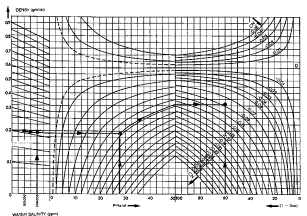|
 Iterative and Error Minimization
Solutions
Iterative and Error Minimization
Solutions
One outcome of the
hydrocarbon density calculation is the possibility that all
prior work is wrong because the wrong fluid density has been
used in the shale volume and porosity equations, resulting
in an incorrect water saturation as well.
 Iterative Methods Iterative Methods
Some programs, notably the service company well site computer
programs and their in-house counterparts perform a series of iterative
solutions to overcome this. The procedure would be as follows:
1.
Apply environmental corrections to raw log data.
2.
Calculate shale volume from any appropriate method.
3.
Calculate porosity from any appropriate method.
4.
Calculate invaded zone and un-invaded zone water saturations.
5.
Calculate hydrocarbon and apparent fluid density.
6.
Calculate correction to density and neutron logs, if fluid density
is less than 0.8 gm/cc 800 kg/m3

Gas
corrections for density (above) and neutron logs (below) for
iterative models.
 7.
Add these corrections to the previous density and neutron log
data.
7.
Add these corrections to the previous density and neutron log
data.
8.
Re-compute shale volume if selected method used density or neutron
log data, using the new density and neutron values.
9.
Re-compute porosity if selected method used density or neutron
log data, using the new density, neutron and new shale volume.
10.
Re-compute saturation using the new porosity and shale volume.
11.
Compare new porosity with previous value.
12.
If there is little change, then go to step 13, otherwise repeat
steps 5 through 12.
13.
Calculate other results desired with the final shale, porosity
and saturation values.
This
process is indicated in the flow diagram at right,
Since
other parameters may be in error, particularly shale and matrix
assumptions, the iteration may not converge, so a trap must be
put in the program to exit after some reasonable number of iterations
defined by the user. Even if it does converge, the result may
still suffer from poor data or poor assumptions.
Due
to gas effect on sonic data, iteration could improve results from
this method provided some relationship could be quantified between
Sxo and the fluid travel time. This relationship is not well known
and is not likely to be helpful at the present time.
 Error Minimization Methods
Error Minimization Methods
Error minimization solutions are also iterative methods. Computer
products such as Schlumberger's GLOBAL and Gearhart's ULTRA are
programs of this type.
The
steps taken are as follows:
1.
Apply environmental corrections to raw log data.
2.
Calculate shale volume from any appropriate method.
3.
Calculate porosity from any appropriate method.
4.
Calculate invaded zone and un-invaded zone water saturations.
5.
Calculate lithology and mineral fractions (see Chapter Nine)
6.
Calculate theoretical log response based on above answers from
appropriate log response equations.
7.
Compare calculated response with actual logs and calculate error
statistics.
8.
Sum these errors and compare to previous iterations.
9.
If error is minimum go to Step 11
10.
If error is not minimum, adjust analysis parameters and analysis
model and repeat Steps 2 through 10.
11.
Calculate other results desired with the final shale, porosity
and saturation values.
If
this method is used in an interactive program, the analyst can
be involved in the decision process of Step 10. If the computer
program contains the decision making logic, it works best when
the analyst has described the best model, and may fail to give
reasonable results when an inappropriate model has been presented.
|

